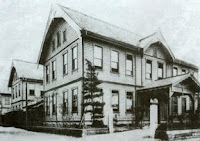

"Bashamichi (Horse-Drawn Carriage Road) was built in 1866 to provide a straight roadway to Kaigan-dori (the harbor road) from Yoshidabashi (the main entrance to the foreign settlement). The road was wide enough for carriages; hence its name. Eighty percent of the people who entered of exited the Gated Within crossed Yoshidabashi. (…) The concentration of banks and insurance companies made Bashamichi the Wall Street of Yokohama. Bashimichi bustled (…)
Within the Gates but outside the Settlement, Bashamichi served as a conduit for the introduction of Western things. In 1862 Shimooka Renjo set up Japan’s first photo studio on Bashamichi. The street merchants competed in planting willows and pines in front of their shops in 1867; and Japan acquired the first roadside trees in her modern era. One Machida Fusazo set up a shaved ice shop on Bashamichi in 1869. Soon he was selling ice cream. It was too expensive for Japanese, but Machida had an occasional foreign customer. A foreigner eating ice cream was a sight to behold. The Japanese came to watch.
In October 1872 Bashamichi was illuminated by Japan’s first gas lamps.
(Burritt Sabin, 'A historical guide to Yokohama', ed. Yurindo, Yokohama, 2002, p. 96-98)
------
"Towards the harbor on the right side of Bashamichi, you’ll find the Taiyo no Boshizo, or "mother-and-child in the sun" statue, which marks the site of the first ice cream parlor begun by Richard Risley in 1865 with imported ice. One serving aisukirin cost the equivalent of 8,000 yen in today’s prices, or roughly half a month’s salary for the common man, even though its consistency and taste were more like sherbet than ice cream as we know it today.
At first the Japanese gathered to gawk at the Westerners eating the strange concoction. Some braver souls gave it a try, but on more than one occasion when a customer discovered that the cool treat was made from cow discharge, he or she rushed outside and vomited violently. In 1869 Machida Fusazo opened the first Japanese ice cream parlor. A local company reproduced a close replica of these early ice creams based on original recipes. Bashamichi Aisu, as it is known, is available in four flavors at Aioi Coffee Shop as well as at Shogo Department Store."
(John Carroll, 'Trail of Two Cities', ed. Kodansha, Tokyo, 1994, p. 49)



















